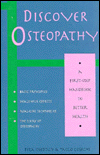Three of the main principles of osteopathy are:
1. Structure and function are interdependent
2. ?The rule of the artery is supreme?
3. The unity of the human being
1. Structure and Function are Interdependent
Life is a dynamic process in which change is the only constant and so its main characteristic is motion. Motion ? or movement ? within a healthy, balanced body (or any other living thing) is fluid and rhythmical. Free movement between the body structures is essential for the health of an individual. When it is disrupted the function is in some way disturbed. Disrupted movement is the altered state that comes about before disease emerges.
When we use the term structure, we mean the muscles, bones ligaments, organs, and fascia. By the term function, we mean the way in which all the different parts of the body work within themselves and in relation to each other. The relationship between structure and function applied in a therapeutic context is probably the greatest contribution made by Andrew Still to medicine. A very good example of this relationship is the young, growing brain. The amount of varied activity that stimulates the brain to work also influences the rate and quality of the growth of the brain tissue itself.
The structure of the circulatory system is the heart, blood vessels, their valves, and the blood. If the blood vessel walls get thicker and harder ? which may be caused by an imbalance in the contents of the blood ? then problems may develop in the circulation.
The osteopath looks for free movement between the joints. In the spine, for example, she looks for flexibility and mobility, as without these the blood and nerve supply to the surrounding and related tissues and organs will be poor. In treatment, the osteopath aims to have a positive effect on the body?s function, even though she works directly on the structure.
2. The Rule of the Artery Is Supreme?
This expression means that, for good health, good circulation of all body fluids is essential. Poor circulation is likely to mean that the cells will be starved of what they need to survive, and will eventually die. All the tissues in the body are made up of different kinds of cells, which get their nutrients from the fluid in which they live. The body fluid consists of the blood, lymph, which drains and cleans the tissues, and the spinal fluid that supports, nourishes and drains the central nervous system. In order for the nutrients to be easily absorbed and for waste products to be got rid of, three conditions need to be fulfilled:
* the fluid must be present in sufficient quantity
* the rhythmic movement of the cells must be constant
* the body fluids must circulate freely
The circulatory system carries the hormones produced by the endocrine system and is controlled by the nervous system. The two systems that form a communication between all the systems of the body are the nervous and circulatory systems. In his writing, Dr. Still often emphasized the importance of one particular system ? the musculoskeletal system, the lymphatic system, the fascia, etc. The reason for this was probably his intuition that in each individual case, one system was the most important factor in creating the disease. At the same time, he always maintained his vision of the unity of the whole body.
3. The Unity of the Human Being
According to the Western Christian tradition, the human being consists of a threefold unit: body, mind, and spirit. This view was adopted by many of the first osteopaths and it is still held by many practitioners today. The relationship between the mind and the body is now taken into consideration by most physicians and health-care professionals. The effect of emotions such as fear, laughter, or sadness on the body, for example, is immediately apparent.
This unity of the body, and its self-healing capacity, is also evident in the neurological, endocrine, and immune systems. In the past decade, researchers have discovered that chemical substances (a variety of hormones and neurological transmitters) produced by the body are recognized by, and communicate with, these three systems. This process is a means by which the body sets in motion its healing mechanism.
For example, an inflammation in the tissues results in the release of substances that increase circulation and temperature, and cause increased sensitivity or even pain by irritating the nerve endings. This information travels in the spinal cord, and some of it goes to the brain, where it stimulates the release of hormones into the blood. It also brings to our conscious awareness the local problem. Once in circulation around the body, these hormones will affect different organs and interact with the immune system. In this way, the whole body is woken up and works as a complete unit to bring things back to normal.
The nervous and circulatory systems not only integrate the normal functions of the body but, if disturbed, can inhibit the body?s natural powers of self-healing. The body?s musculoskeletal system reflects, and may aggravate, the condition of these systems and so influence a person?s state of health. When an osteopath thinks of the interconnectedness of the body he has in his mind all of these systems.
Osteopathy and the Holistic Approach
A holistic approach to health means that every part of the body is seen within the context of the whole; that whole is more than the sum of the parts. As all the organs and systems of the body are interconnected, we cannot treat one part without influencing and changing the whole. This may mean that the cause of a problem may be far from where the symptoms are found.
A patient who has had a whiplash injury in a car accident, for example, may complain of pain in the leg. Tension in the lower back may be causing this pain, but as the primary problem is located in the neck, until this is resolved there is little chance that the symptoms will clear. The osteopath will therefore take great care in treating the neck, as well as the leg and back. This approach will release the stress in the nervous system and help the body to recover as a whole.
Practicing Osteopathy
Dr. Andrew Still said: ?Find it, fix it, and leave it alone.? These words sum up how the principles of osteopathy may be applied to treatment. As the path to cure lies inside the patient?s body, treatment is directed toward removing some of the obstacles that are stopping the healing process from taking place spontaneously. Overtreatment is a mistake ? the osteopath must respect each patient?s own rhythms and the pace at which each person functions and so can heal. The practitioner needs to offer the space and time for the individual to carry out their own self-healing.
By acknowledging the uniqueness of each individual, in every treatment session there is a key point for the mind and body which, if properly corrected, will in time bring about a broad and deep change in that person?s situation. In order to find the key point, the osteopath must be, as much as possible, in tune with the patient.
What is Healing?
Dr. Still emphasized in all his books the importance of mind-matter-motion. He identified ?mind? with man?s spiritual being, which can maintain the body in good health only by tuning in to nature?s ?mind?. Behind this, for Still, lay the will of God, the Mind of all minds. Motion was central to Still?s thinking because he saw in it the very expression of life.
With this as a starting point, we can say that health is a dynamic process characterized by every aspect of a human being -- the thinking, social, physical, and spiritual components that go to make up the whole person. A deep healing cannot take place without the combination of all of these parts in our lives.
The way in which the body and mind are linked in the process of healing may be as follows. Within ourselves, we have a series of built-in, automatic reflexes ranging from physiological homeostatic mechanisms, to those that regulate our behavior patterns. These mechanisms can become locked in a circle of self-repetition that may eventually lead to disease. An example of this may be a person who has been under a great deal of stress; because of this, he develops an increasing level of anxiety and starts to eat compulsively. This in turn may in time lead to diabetes. So a conditioned pattern of behavior becomes locked in a vicious, self-repeating circle.
Another example could be an elderly woman who breaks her hip. Consequently, she is bedridden for several weeks, becomes depressed, loses interest in food, and eventually dies prematurely.
On the other hand, we also have a natural tendency toward self-improvement, which means that we can function more efficiently both psychologically and physically. Psychologically, this tendency is characterized by the conscious effort we make toward an increasing self-awareness that can break down unbalanced, conditioned behavior and be our source of continual growth.
Healing spans an extremely wide range, from getting rid of a common cold, to achieving a well-balanced personality. It is, of course, not necessary to go through a deep inner change in order to cure a cold. On the other hand, to heal from serious illness such as cancer may require ? along with the appropriate medication ? a total transformation and an awakening. Healing goes hand in hand with a feeling of well-being and the return to a joyous personality.
Treatment and Healing
Healing does not always coincide with treatment. Whether the treatment takes the form of manual manipulation, surgery, drugs, or counseling, healing will not always follow and may come about months or years after clinical treatment. One definition of healing may therefore be that a person is functioning to the best of her potential and is therefore healthy. An example of this is a child who, after a fracture, has one leg slightly shorter than the other. He suffers from low back pain and has a limp; he may also have problems with his digestion and difficulty in sleeping. Osteopathic treatment may help with the back pain, digestive and sleeping problems, but the length of the child?s leg may be irreparable. So we could say that he is healing when he is back to functioning as well as he can, given that circumstance.
Osteopathy and Other Therapies
Chiropractic
Chiropractic and osteopathy both had their origins in the U.S. toward the end of the nineteenth century. Dr. Daniel Palmer, the founder of chiropractic, is believed to have spent some time studying with Dr. Still. Following that study, Dr. Palmer moved to another state and started his own personal healing discipline. Chiropractic means manual treatment ? it is formed by two Greek words, chiro, meaning hands, and praktikos, meaning done by.
There are similarities and differences between the two therapies. Palmer first stressed the role of the nervous system and of the spinal column in health and disease, seeing nerve compression as the basis for all problems. Chiropractors are more likely to use X-rays when diagnosing a patient?s problem. They also concentrate on manipulation of the spine, directly adjusting it with rapid movements.
Physiotherapy
The differences between osteopathy and physiotherapy are mainly found in their underlying philosophies. They do not use drugs, but manual treatment, exercises, and electrotherapies. In the past, physiotherapists did not make diagnoses, but worked with a patient after the doctor?s diagnosis.
Physiotherapists are experts in their field and they work in collaboration with osteopaths in various cases. Over the past hundred years of its life, the profession has changed greatly and it is interesting to see how the attitude and approach of physiotherapists has come to appreciate other methods of treatment. They maintain that they are moving toward a more holistic approach to health and patient management.
 This article was excerpted from
This article was excerpted from
Discover Osteopathy
by Peta Sneddon & Paolo Cosechi
About The Author
Peta Sneddon and Paolo Cosechi are registered osteopaths who share a private practice in Chianti, Italy. This article was excerpted with permission from "Discover Osteopathy" published by Ulysses Press. Ulysses Press/Seastone Books are available at bookstores throughout the US, Canada, and the UK, or can be ordered directly from Ulysses Press by calling 800-377-2542, faxing 510-601-8307, or writing to Ulysses Press, PO Box 3440, Berkeley, CA 94703, email























